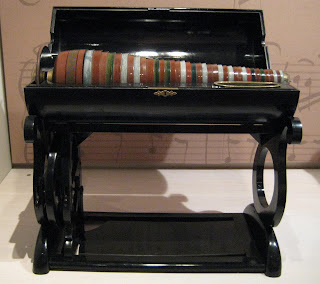The first things that I went looking for in the museum's collection were the bassoons. I found six instruments that can be properly termed a bassoon along with one contra-bassoon.
 The instrument on the right is the earliest bassoon that the museum had on display. It was made in Prague by C. Schramme around 1700. The extremely basic keying is reminiscent of the keying used on more advanced recorders. This is probably why the instrument is displayed alongside a bass recorder that was also made my Schramme around the same time. It is hard to believe that an instrument of this size would be able to play in as a low a register as the contemporary bassoon. In this way this bassoon still resembles its duclian heritage much more than contemporary designs.
The instrument on the right is the earliest bassoon that the museum had on display. It was made in Prague by C. Schramme around 1700. The extremely basic keying is reminiscent of the keying used on more advanced recorders. This is probably why the instrument is displayed alongside a bass recorder that was also made my Schramme around the same time. It is hard to believe that an instrument of this size would be able to play in as a low a register as the contemporary bassoon. In this way this bassoon still resembles its duclian heritage much more than contemporary designs. For a while I thought that I would not find any other bassoons in the museum, but then I ran across this display case full of them. From left to right they are 1) made by Jan Hovak in Prague between 1860 and 1890, 2) made by Theodore Lotz in Vienna in the late 1780s, 3) made by F. Pitschmann in Arnsdorf (Germany) in the nineteenth century, 4) made by G Keyha in Prague around 1800, 5) the contrabassoon made by Simon Josef Truska in Prague also around 1800.
For a while I thought that I would not find any other bassoons in the museum, but then I ran across this display case full of them. From left to right they are 1) made by Jan Hovak in Prague between 1860 and 1890, 2) made by Theodore Lotz in Vienna in the late 1780s, 3) made by F. Pitschmann in Arnsdorf (Germany) in the nineteenth century, 4) made by G Keyha in Prague around 1800, 5) the contrabassoon made by Simon Josef Truska in Prague also around 1800.All of these bassoons, though not as old as the Schramme model, were still made before Heckel revolutionized the keying system, producing what is ostensibly the contemporary standard for the instrument. This collection of bassoons demonstrated some interesting experimentation at a time when the design was still being finalized. The Hovak model (number 1, far left) is interesting because it has a bell similar to the directional bells used on brass instruments. One only needs to look at a modern bassoon to figure out that this was a dead end. It is also interesting that this instrument was made so late. By the 1860s, Heckel would have been producing a demonstrably superior instrument.
 Looking at the picture on right, one can also see that the shape of the bocal (that is the metal tube that connects the reed with the wing joint) was still being heavily experimented with. Although bocal sizes and shapes remain variable to this day, they generally do not vary to this great extent. For the most part the girth of the tube that makes up the bocal is what has remained significantly optional, not the overall shape. Of particular note is the bocal on the contrabassoon (number 5, far right); it actually bends up. There are no contemporary designs that include this feature. This contrabassoon is also notable for being upright. The body of contemporary contras circle around once more and thus remain about the same height as a regular bassoon, they just end up significantly wider.
Looking at the picture on right, one can also see that the shape of the bocal (that is the metal tube that connects the reed with the wing joint) was still being heavily experimented with. Although bocal sizes and shapes remain variable to this day, they generally do not vary to this great extent. For the most part the girth of the tube that makes up the bocal is what has remained significantly optional, not the overall shape. Of particular note is the bocal on the contrabassoon (number 5, far right); it actually bends up. There are no contemporary designs that include this feature. This contrabassoon is also notable for being upright. The body of contemporary contras circle around once more and thus remain about the same height as a regular bassoon, they just end up significantly wider.Along with the bassoons, I found a number of other, perhaps less-odd instruments to enjoy at the Czech Museum of Music.
 I found this accordion made by someone named Josef Hlavacek. Joseph is my grandfather's name and the surname is pretty close to ours. I am forced to wonder if perhaps I have distant accordion-making relatives. Although this seems unlikely (the difference between and E and an I is not incidental in Czech), it was cool to see something like my family's name printed on anything. This never happens in the States for me.
I found this accordion made by someone named Josef Hlavacek. Joseph is my grandfather's name and the surname is pretty close to ours. I am forced to wonder if perhaps I have distant accordion-making relatives. Although this seems unlikely (the difference between and E and an I is not incidental in Czech), it was cool to see something like my family's name printed on anything. This never happens in the States for me. Another highlight of the museum for me was getting to see two glass harmonicas. The harmonica's as they are constructed here, are based on a design by Benjamin Franklin. I still have never seen one in use and would like to one day. Every now and then the glass harmonica will make it into popular or sub-popular culture. My favorite use of the instrument is on , Entroducing..., a DJ Shadow's album. The instrument works by stepping on the flat panel near the floor. This spins the glass bowls above. Then the player soaks his or her hands in water which would be put into the metal wells on both sides of the bowls. The player then drags his or her wet fingers over the bowls to produce an soft humming sounds.
Another highlight of the museum for me was getting to see two glass harmonicas. The harmonica's as they are constructed here, are based on a design by Benjamin Franklin. I still have never seen one in use and would like to one day. Every now and then the glass harmonica will make it into popular or sub-popular culture. My favorite use of the instrument is on , Entroducing..., a DJ Shadow's album. The instrument works by stepping on the flat panel near the floor. This spins the glass bowls above. Then the player soaks his or her hands in water which would be put into the metal wells on both sides of the bowls. The player then drags his or her wet fingers over the bowls to produce an soft humming sounds.



No comments:
Post a Comment